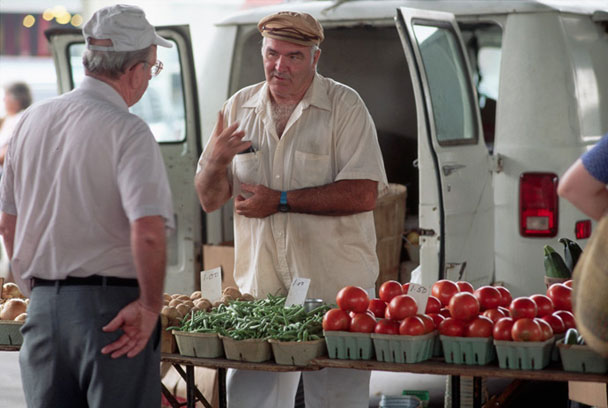When I left the city for farming, I carried some whopping misconceptions with me. Like the idea that bulls come with horns and cows don’t, or that you need roosters in order to get eggs from hens. Wrong and wrong. I also thought farming would be a pretty simple endeavor for a worldly chick like me. Excruciatingly wrong. I’ve got eight years’ worth of dirt under my nails now, and while I still have a lifetime of learning to do, I can at least hold my own in the nerdy conversations—about weed control, cover crops, artificial insemination—that farmers find absorbing when we are among our own kind.
The fact that I had to learn everything from scratch made me realize that our society is pretty much agriculturally illiterate. It wasn’t always like this. Until a hundred years ago, 30 percent of the labor force worked on farms, and farms were everywhere, tucked into good soil right up to the city limits. If you didn’t farm yourself, you at least knew, more or less, how it was done. That is no longer true. Fewer farms feed more people, only 2 percent of the labor force is in agriculture, and there is more distance between where food is produced and the population centers where it is consumed. Farming—the most fundamental, earthy, and necessary work in the world—has become esoteric, exotic, mysterious. Meanwhile, it has also gotten way more complicated.
The result is a great gulf of understanding between the people who produce food and those who eat it. At the industrial end of the farming spectrum, agricultural practices have evolved so far from what many people consider acceptable that producers have lobbied legislators to make it illegal for pictures to be taken of their operations. Proponents of such “ag gag” bills—which died in state legislative sessions in Florida, Iowa, Minnesota, and New York this year—have argued that agri–ignorant people tend to take images out of context and don’t understand that there’s a reason for the measures industrial producers take, from housing hens in battery cages to confining sows in restrictive farrowing crates. But there is confusion even at the other end of the spectrum, in the realm of small farms. Even on this scale, in a cozier system where the distance—physically and philosophically—between producers and consumers tends to be much smaller, there can be gaps in understanding between the small farmers who sell at farmers’ markets and through CSAs, on the one hand, and their customers, the eaters who are really paying attention, and care how their food is raised, on the other.
Labels can help, to an extent. Certified organic means that a farm conforms to the national organic standard set by the USDA, and certified farms are inspected by one of several certifying agencies, to keep things honest. But not every organic farm is the same. There are big ones and small ones, good ones and bad ones, just as there are with conventional farms. There are also plenty of farms without labels that meet or exceed organic standards, or use other, less–specific nomenclature—naturally raised, free–range, naturally fed, and the like. In the end, there’s no single right way to farm, and farm systems are much too chaotic for perfection. What matters to one consumer, like pesticide residue or soil erosion, isn’t what matters to the next one, who is more interested in farm worker rights, or fossil fuel consumption.
So, it’s complicated. Still, you, the consumer who cares about your food, deserve to understand what you’re getting for your money. The only way to do that is to ask your farmers good questions about their practices, and be willing to pay when you get the answers you want to hear. But first, you need a certain degree of agri–literacy. So I’m offering my services as translator between those who speak dirt and those who eat what comes out of it. Here are three misconceptions I’ve heard visitors or CSA members voice on our farm, followed by the straight—if nuanced and complicated—story and some questions you yourself can ask to help clarify things, while simultaneously making you sound supersmart to your farmer.
Misconception #1: Local is kind of the same as organic.
Nope. Local only describes a farm’s location, not its agricultural practices or its scale, which can run the gamut from beyond organic to totally conventional, from a small pampered flock or herd to a CAFO. (That’s a concentrated animal feeding operation, but you’ll get more cred with your farmer if you just say KAY–fo.) A good starter question for a noncertified local farm would be, “How do your practices differ from organic standards?” That should cover what they might spray on their fields and what they feed to their animals as well as their policies on fertilizer, hormones, and antibiotics. Your follow–up might be to ask why they do it that way. Don’t be afraid to tell farmers what you’re hoping to hear, and what you’d be willing to pay a premium for.
Misconception #2: Organic farms don’t use chemicals.
There is a long list of pesticides, herbicides, fungicides, fertilizers, medications, and ingredients approved for use on certified organic farms. For example, pyrethrum is a pesticide approved for both plant and animal production. It’s naturally derived from chrysanthemums but has the same active ingredient as its synthetic cousin permethrin, a conventional pesticide. Both act on the nervous system of insects, and both kill beneficial bugs as well as pests. Some organic growers have extensive spray regimes, while others spray nothing and focus on crop rotation and healthy soil to help plants resist disease and insect damage. A great question to ask a certified organic farmer is, “What inputs do you use?” Inputs are just the products—from fertilizers and pesticides to diesel and animal feed—that a farmer buys instead of producing on–farm. Some farmers aim to reduce their inputs for economic reasons, and others for environmental reasons, but low–input farming is generally considered more sustainable.



 Pinterest
Pinterest


